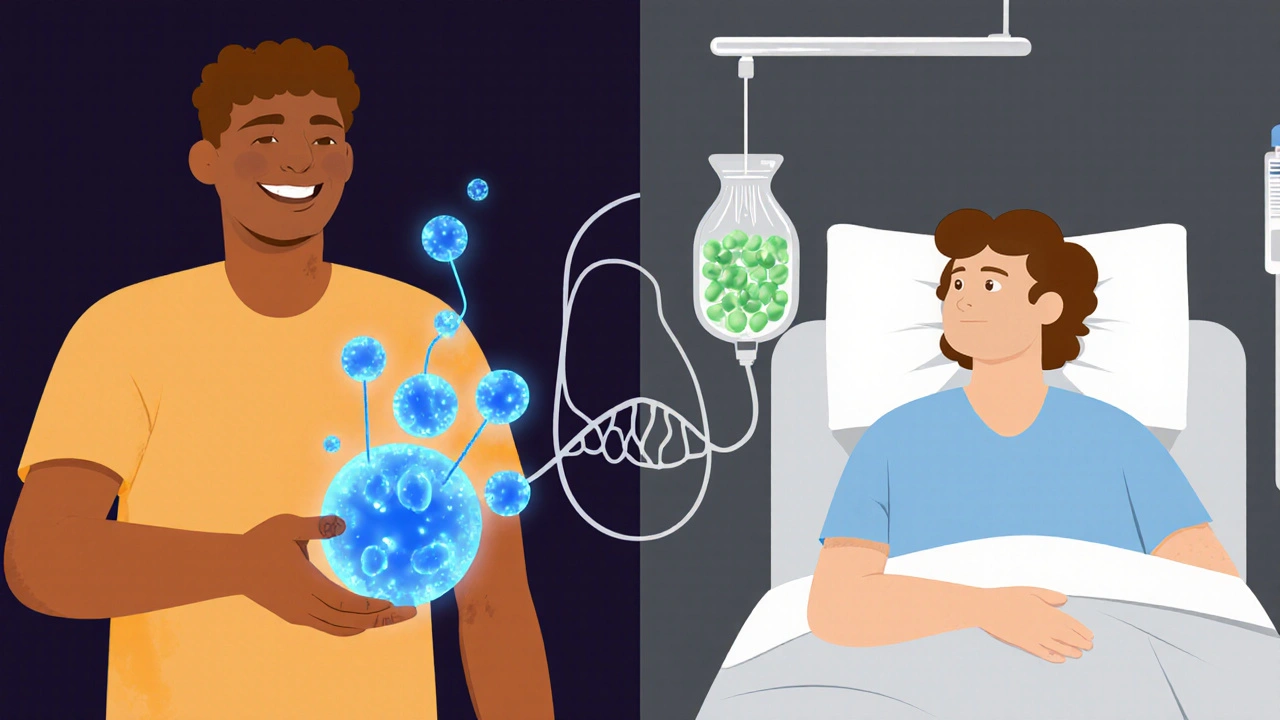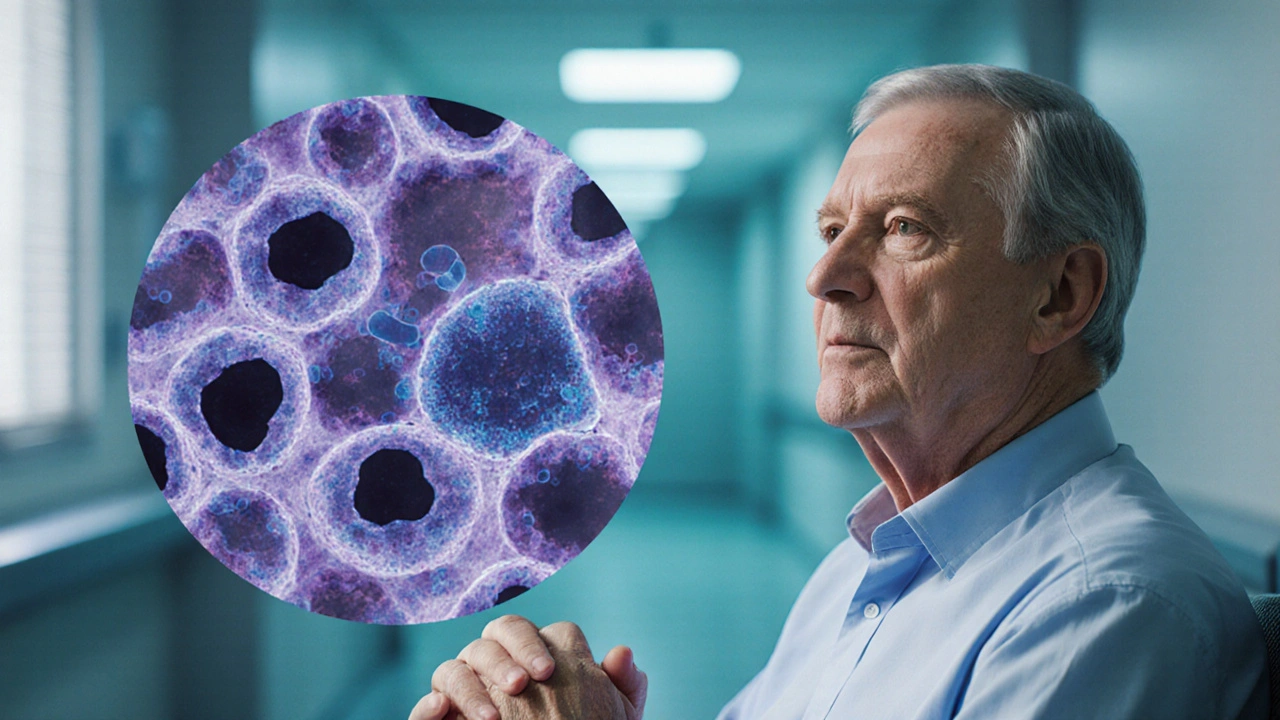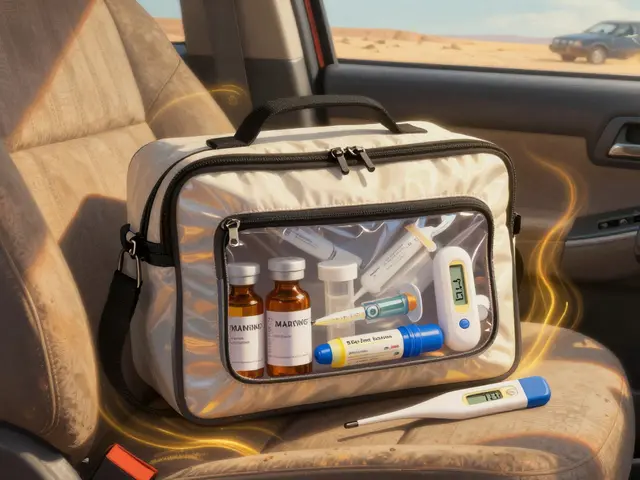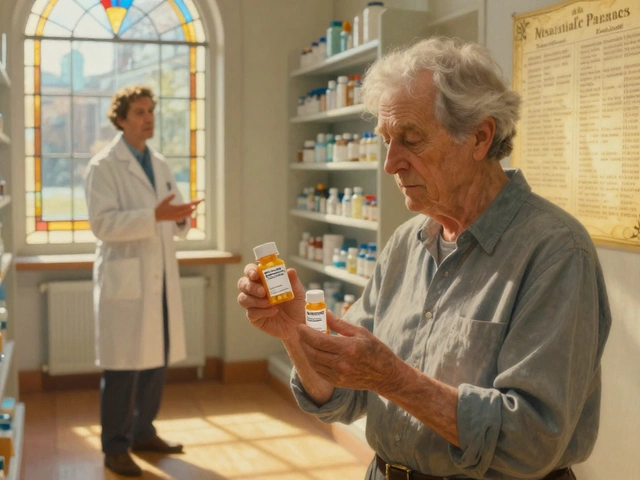CLL Stem Cell Transplant Comparison Tool
Use this interactive tool to compare key features of allogeneic and autologous stem cell transplants for chronic lymphocytic leukemia (CLL).
Uses stem cells from a matched donor. Offers strong graft-versus-leukemia (GVL) effect but carries risk of graft-versus-host disease (GVHD).
- Donor Source Matched donor
- GVL Effect Strong
- GVHD Risk High
- Typical Age Limit Up to 70 years
Uses the patient's own stem cells. Lower risk of complications but lacks graft-versus-leukemia benefit.
- Donor Source Patient's own
- GVL Effect None
- GVHD Risk None
- Typical Age Limit Up to 75 years
| Metric | Allogeneic | Autologous |
|---|---|---|
| 5-Year Overall Survival (High-Risk CLL) | ≈55% | ≈30% |
| Common Complications | GVHD, Infections, Organ Toxicity | Infections, Delayed Engraftment |
Important Considerations
Transplant decisions depend on multiple factors including age, overall health, disease genetics (like TP53 mutations), and availability of suitable donors. Both approaches have distinct advantages and risks.
Recommended Approach
Chronic lymphocytic leukemia (CLL) is the most common adult leukemia in North America, and while many patients do well with drug therapy alone, a subset eventually needs a more aggressive approach. One of the most powerful options is a stem cell transplant, a procedure that can reset the blood‑forming system and give the immune system a new chance to fight cancer.
Key Takeaways
- Stem cell transplants can be curative for high‑risk CLL, especially when combined with targeted drugs.
- Allogeneic transplants offer a graft‑versus‑leukemia (GVL) effect but carry higher risk of graft‑versus‑host disease (GVHD).
- Autologous transplants are less risky but provide limited long‑term disease control.
- Eligibility depends on age, comorbidities, disease genetics (e.g., TP53 mutation), and donor availability.
- Post‑transplant monitoring, infection prophylaxis, and early detection of relapse are critical for success.
What Is Chronic Lymphocytic Leukemia?
Chronic Lymphocytic Leukemia is a slow‑growing cancer of B‑lymphocytes that typically presents in older adults. Patients often feel fine at diagnosis, but the disease can progress to bulky lymph nodes, anemia, or severe infections. Genetic abnormalities like del(17p) or TP53 mutations signal a poorer response to standard chemo‑immunotherapy, prompting clinicians to consider a transplant earlier.
Defining Stem Cell Transplant
A stem cell transplant (also called hematopoietic stem cell transplant or HSCT) involves replacing a patient’s diseased bone‑marrow cells with healthy stem cells capable of generating all blood lineages. High‑dose chemotherapy or radiation first wipes out the existing marrow, creating space for the infused cells to engraft and start producing normal blood cells.
Allogeneic vs. Autologous Transplants
The two main transplant strategies differ in the source of stem cells and the biological mechanisms that help control leukemia.
Allogeneic Stem Cell Transplant
In an allogeneic stem cell transplant the donor’s stem cells come from a matched sibling, unrelated donor, or a cord‑blood unit. The donor’s immune cells can recognize and kill residual leukemia cells - this is the graft‑versus‑leukemia (GVL) effect.
Autologous Stem Cell Transplant
An autologous stem cell transplant uses the patient’s own harvested stem cells, which are stored before high‑dose therapy and then reinfused. Because the cells are self‑derived, there is no risk of GVHD, but the GVL benefit is absent.
| Feature | Allogeneic | Autologous |
|---|---|---|
| Stem‑cell source | Matched donor (sibling, unrelated, cord‑blood) | Patient’s own peripheral blood stem cells |
| Graft‑versus‑leukemia effect | Strong - donor immune cells attack residual CLL | None |
| Risk of graft‑versus‑host disease | Present (acute & chronic GVHD) | Absent |
| Typical eligibility age | up to 70years (if fit) - often lower due to GVHD risk | up to 75years |
| 5‑year overall survival (2023‑2024 data) | ≈55% for high‑risk CLL | ≈30% for similar risk group |
| Common complications | GVHD, infections, organ toxicity | Infections, delayed engraftment |

When Is a Transplant Considered?
Transplant isn’t the first line for most CLL patients, but several clinical signals push the needle toward an early transplant decision:
- Presence of TP53 loss or mutation - predicts failure of chemo‑immunotherapy.
- Refractory disease after a BTK inhibitor (e.g., ibrutinib) or BCL‑2 inhibitor (venetoclax).
- Rapid disease progression (doubling time <6months) despite targeted agents.
- Young or middle‑aged patients (<65years) with good performance status (ECOG0‑1).
Clinicians also evaluate comorbidities using the HCT‑CI (Hematopoietic Cell Transplantation‑Specific Comorbidity Index) and assess donor availability through HLA matching high‑resolution typing at HLA‑A, B, C, DRB1, and DQB1 loci.. A 10/10 match dramatically lowers GVHD risk.
The Graft‑Versus‑Leukemia Effect
The true power of an allogeneic transplant lies in the graft‑versus‑leukemia effect a donor‑immune‑mediated attack that can eradicate residual CLL cells after conditioning. Studies from 2022‑2024 show that patients who develop mild chronic GVHD actually enjoy higher long‑term disease‑free survival, underscoring the delicate balance clinicians must strike.
Risks and How They’re Managed
Every transplant carries a cocktail of short‑ and long‑term risks. Here’s what patients typically face and how modern protocols address them:
- Acute GVHD: Usually appears within 100days; treated with high‑dose steroids and newer agents like ruxolitinib.
- Chronic GVHD: Can affect skin, liver, eyes, and lungs; managed with topical therapies, calcineurin inhibitors, and physical rehabilitation.
- Infections: Prophylactic antibiotics, antivirals (acyclovir), and antifungals (posaconazole) are standard for the first year.
- Organ toxicity: Reduced‑intensity conditioning (RIC) regimens (fludarabine+busulfan) lower cardiac and pulmonary injury in older patients.
Supportive care teams now use real‑time cytokine monitoring and tele‑health check‑ins to catch complications early.
Post‑Transplant Monitoring and Relapse Prevention
After engraftment, the focus shifts to surveillance:
- Monthly complete blood counts for the first six months.
- Minimal residual disease (MRD) testing using flow cytometry or next‑generation sequencing - a negative MRD at day100 predicts excellent outcomes.
- Immunizations begin around 12months post‑transplant (influenza, pneumococcal, COVID‑19).
- Regular assessment of graft‑versus‑host disease activity and quality‑of‑life questionnaires.
If MRD reappears, clinicians may re‑introduce BTK inhibitors or trial novel agents like venetoclax‑based maintenance.
Emerging Trends: From CAR‑T to Novel Conditioning
While stem cell transplants remain a cornerstone for high‑risk CLL, the field is evolving rapidly:
- CAR‑T therapy: Anti‑CD19 CAR‑T (e.g., lisocabtagene maraleucel) shows ~70% response in relapsed CLL, but durability still trails transplantation.
- Combination approaches: Early‑phase trials pair venetoclax with reduced‑intensity allogeneic transplants, seeking synergistic MRD clearance.
- Targeted conditioning: Radio‑immunotherapy (90Y‑ibritumomab) before transplant offers tumor‑specific marrow suppression with less off‑target toxicity.
These innovations may shift the risk‑benefit calculus for younger patients, but for now, the allogeneic transplant remains the only curative option for many.

Frequently Asked Questions
Can older patients undergo a stem cell transplant for CLL?
Yes, especially with reduced‑intensity conditioning. Patients up to 70years with good organ function and a suitable donor can achieve comparable remission rates, though the risk of GVHD rises with age.
What is the difference between acute and chronic GVHD?
Acute GVHD appears within the first 100days and often involves skin, liver, and gut. Chronic GVHD develops later and can affect multiple organs, leading to long‑term disability if not controlled.
How long does it take to recover after a transplant?
Neutrophil recovery typically occurs within 2‑3weeks, platelet recovery by 4‑6weeks, and full immune reconstitution can take 12‑24months. Patients usually resume light activities within 2‑3months, but full return to work may take 6‑12months.
Is a stem cell transplant covered by Canadian health insurance?
In Canada, medically indicated allogeneic and autologous transplants for CLL are covered under provincial health plans, but patients may need pre‑authorization and can incur out‑of‑pocket costs for supportive medications.
Can a transplant cure CLL?
Allogeneic transplants can offer a cure in a subset of high‑risk patients, especially when the graft‑versus‑leukemia effect eliminates residual disease. Autologous transplants improve remission depth but rarely eradicate the leukemia completely.







Comments
Steven Young
4 October 2025Stem cell transplants are just a hidden way for pharma to control patients
Kelly Brammer
28 October 2025Choosing a treatment should be guided by compassion and long‑term wellbeing, not just by the latest hype. The medical community has a duty to disclose all risks, especially the severe complications of graft‑versus‑host disease. Patients deserve transparent information to make truly informed choices.
Kevin Hylant
22 November 2025The data clearly show that allogeneic transplants improve survival for high‑risk CLL when matched donors are available. However, the procedure demands rigorous pre‑screening to avoid unnecessary toxicity. Institutions must prioritize eligibility criteria that protect the most vulnerable.
Ben Collins
17 December 2025Ah, the world of stem cell transplants-always a hot topic.
You read the article, you get the tables, you see the survival percentages.
What’s fascinating is that despite the numbers, most patients still hear whispers of “miracle cure.”
The reality is far messier, with conditioning regimens that feel like a weekend in a bunker.
Donors get screened, but the graft‑versus‑leukemia effect is a double‑edged sword.
On one side it attacks residual cancer, on the other it may launch a full‑blown immune attack on the host.
That’s why GVHD remains a nightmare for many clinicians.
Yet, you’ll find centers that have mastered prophylaxis and reduced mortality to below 20 percent.
Age is another factor; patients in their late 60s can still endure the high‑dose chemo if they’re fit enough.
The article mentions TP53 mutations-those are the red flags that scream “don’t wait.”
Targeted therapies like venetoclax can buy you time, but they’re not a substitute for a transplant in high‑risk disease.
Post‑transplant monitoring is a marathon, not a sprint; infections lurk around every corner.
I’ve seen a patient who survived five years only to succumb to a viral pneumonia you wouldn’t expect.
So, the take‑away isn’t that transplants are magic, but that they’re a calculated risk we juggle with precision.
If you’re considering it, talk to a multidisciplinary team and ask about the center’s GVHD rates.
At the end of the day, the decision rests on a balance between quality of life and statistical odds.